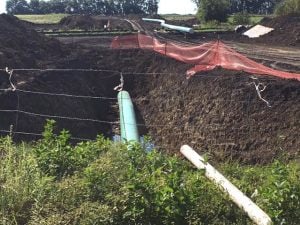The pipeline being constructed by Energy Transfer Partners crossing from North Dakota all the way into Illinois has been experiencing difficulty lately. In North Dakota, construction on the controversial Dakota access pipeline has already been delayed by the successful protests of the Standing Rock Sioux tribe. On Sept. 9, three of North Dakota’s federal judges ordered construction on the pipeline halted and placed it under review. This is a temporary yet major victory for the Standing Rock Sioux tribe and other environmentalists.
In a small town like Carlinville these issues may seem far away, but they are in fact in our backyards. Chemistry adjunct James Pickett has been personally affected by the pipeline. Pickett said, “The pipeline bisects my farmland directly in half.” He owns a substantial amount of farmland to the southeast of Carlinville and rents it out for farmers to plant crops. Picket continued, “Our tenants are unable to plant crops here. They haven’t been able to plant all season.” The land grab may be a large inconvenience but many landowners are afraid to put up a fight. Pickett said, “There is always the possibility that whether you agree to it or not, that Energy Transfer may tell the government, and eminent domain could come into play. This is why most people, including myself sought legal council and just settled for compensation.”
Although the Texas-based company claims on its website that “Today’s crude oil pipelines are designed to exceed stringent federal safety standards,” and “Dakota Access will be built and operated using the most advanced technology and monitoring systems to make it even safer,” Pickett and other landowners are still concerned that if something does go wrong with the pipeline or if there is spillage that their land will be made unusable. Pickett said, “ I’m sure a lot of people are questioning the fact that, with the plethora of oil that we have today, from a number of different sources, is this really necessary? Today I would say probably not; ten years from now I guess it could be significant.”
The pipeline bisects my farmland directly in half.
Although Pickett was frustrated with the pipeline, he also said, “Energy Transfer has done nothing to make me distrust them.” The landowners whose land has been commandeered to build the pipeline are being appropriately compensated as well. The website for the pipeline states, “As an operating principle, Dakota Access Pipeline is committed to working with individual landowners to make accommodations, minimize disruptions, and achieve full restoration of impacted land.”
Earlier this month protesters assembled at the dig site just outside of Carlinville with a sign stating, “No Dakota Oil On Illinois Soil” and cameras to take pictures of the construction. The protesters wanted to bring awareness that construction was still proceeding outside of North Dakota. Protester Josh Bailey says his reason for protesting the pipeline is environmental, “My main concern is the science of climate change and the necessity to move away from fossil fuels, which is encouraged by most every climatologist that exists.”

Bailey continued, “These scientists are telling us to leave [oil] in the ground, and I just can’t support making it easier to pull it out and burn it, which is what these big companies are doing…” The majority of the protesters see the pipeline as a ticking time bomb, that could at any second pollute soil and groundwater, whereas Energy Transfer Partners sees it as an opportunity to make money and make the U.S. less dependant on foreign nations for petroleum. The pipeline has also been useful in providing jobs to construction workers; the Energy Transfer website estimates that the pipeline has created 8,000 to 12,000 jobs.

